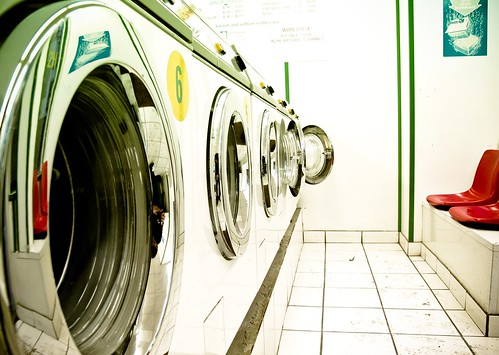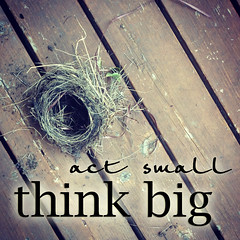guest post by Jennifer B. Robbins
Did you know that one of the most toxic rooms in your home might just be the laundry room? That's because conventional laundry detergent, fabric softener, and dryer sheets all contain toxic chemicals!
In fact, according to a survey of selected scented consumer goods by US National Library of Medicine National Institutes of Health Researchers, many products tested "emitted more than 100 volatile organic compounds (VOCs), including some that are classified as toxic or hazardous by federal laws." That study included some of the most popular laundry detergents and dryer sheets on the market. And if you think unscented products are better, you may be surprised to learn that another study showed that even products advertised as "fragrance-free" still contains many of the same harmful chemicals as their scented counterparts.
So what does that mean? Essentially, it means that with each load of laundry we do with conventional laundry products, we are releasing a potentially dangerous mix of toxic chemicals into the air. That means that not only are we subjecting our bodies to the toxic chemicals by wearing clothes that were washed in them, we are also breathing in the toxic fumes.
And the worst part is many of us have no idea we're doing it! That's because companies are not required to disclose a full list of ingredients on their products. They can include chemicals like Nonylphenol Ethoxylate (an endocrine disrupter that can mimic the effects of estrogen), 1,4-Dioxane (a carcinogen linked to organ toxicity that can contaminate groundwater), and various sulfates (Sodium Lauryl Sulfate & Sodium Laureth Sulfate for examples, which are known skin irritants). But you would have no idea these chemicals are in your products because none of them are listed on the labels.
Thankfully, there are several organizations out there doing the dirty work for us. You can check the Environmental Working Group (EWG) website to find out what exactly is in your favorite laundry detergent, and see what rating they are given (A - F based on the relative level of concern posed by exposure to the ingredients). For example, the detergent I used to use received a D rating. The label of the detergent listed ingredients as "biodegradable surfactants (anionic and nonionic), enzymes". The actual list of ingredients is far too long to list here but includes several ingredients that have been linked to cancer, vision loss, and other serious problems. Scary, huh?
Now that we know the dangers of toxic laundry detergent, how can we avoid it? Here are a few options:
Make your own laundry detergent. There are tons of high-quality recipes out there. I shared my favorite on my own blog recently. It's a powder form that I store in reusable mason jars, so not only does it keep chemicals out of my laundry, it keeps plastic containers out of a landfill. It also ends up being much more economical (you could save $100s a year). If you'd like to try some other recipes, check out the links below. Please be sure to check if the recipe works for HE washers (most do) and if it is compatible with cloth diapers if you use them (some aren't).
Buy
safe laundry detergent. I know I've
just gone on about the dangers of conventional laundry detergent, but
it is possible to find safe ones. The EWG has nearly a dozen laundry
detergents with an A rating. The three listed below are
also certified green and animal cruelty-free, as well. (Word of
warning: they are a little pricey, which is why DIY detergent is my
go-to laundry choice.)
Try Soap
Nuts. I've
actually never tried this method, but people swear by them. Soap
Nuts are 100% natural dried fruit that gets your laundry
clean with zero scent or chemicals! The outer shell of the
soapnut contains saponin, a natural substance known for its ability
to cleanse and wash. To use them, simply put 5-6 nuts in the
muslin bag that should comes with your purchase and wash your
clothes as usual. This bag of nuts will usually last 5 to 8
loads; until the nuts turn gray. The nuts are totally
biodegradable, so you can use them as mulch in your garden when
they're no longer useful for your laundry! A few tips about soap
nuts:
- Buy seedless nuts. Soap Nuts are sold by weight, and the seeds do not help in the cleaning process. So buying seedless means you are getting more of the outer shells, which is what actually does the cleaning.
- Buy in bulk if possible. The more you buy at once, the cheaper each load is.
- Do research before you buy. There are lots of variations of Soap Nuts, and lots of different vendors. Don't buy the first thing you see! Check out reviews, find out where the nuts come from, and make sure you are getting a quality product before you buy.
It
may seem like a small change, but when you think about how many loads
of laundry you do a year, switching to a non-toxic laundry
detergent could make a huge difference! You would be eliminating
not only your family's contact with toxic chemicals, but also the
amount of toxic chemicals being released into the air. Imagine if
everyone stopped releasing all those hazardous VOCs into the air
daily. What a huge effect such a small change could have.
Stand by for Jennifer's companion post Toxic Laundry: Skip the Fabric Softener, coming next week!
Jennifer is a blogger, professional writer, and reluctant accountant. She loves DIY projects, Dr. Pepper, and searching for treasures in thrift stores. She's kinda crunchy but definitely opinionated. Jennifer resides in small town Oklahoma with her new husband, puppy, and kitty. You can visit her online at Mrs. Robbins Sparkles.
Stand by for Jennifer's companion post Toxic Laundry: Skip the Fabric Softener, coming next week!
* * *
Jennifer is a blogger, professional writer, and reluctant accountant. She loves DIY projects, Dr. Pepper, and searching for treasures in thrift stores. She's kinda crunchy but definitely opinionated. Jennifer resides in small town Oklahoma with her new husband, puppy, and kitty. You can visit her online at Mrs. Robbins Sparkles.
Photo credit: Bonnaf via Creative Commons









0 comments:
Post a Comment